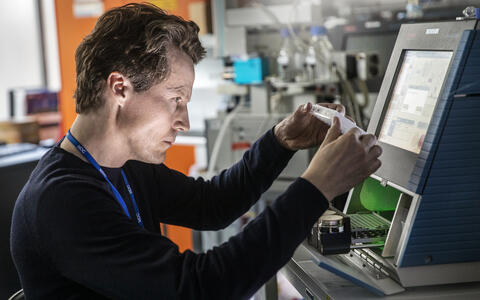The protein detective
Matthias Selbach could be described as a “protein detective,” hunting down those involved in biological processes and zeroing in on anything that strikes him as unusual. Proteins play a major role in health and disease. For example, a single protein called M1 can determine whether or not a bird flu virus can be transferred from waterfowl to humans and trigger a pandemic.
Selbach’s preferred method for hunting down proteins is mass spectrometry. Mass spectrometers work a bit like scales, determining proteins and other biomolecules by their weight. These measurements produce long lists of numbers that can provide information on how frequently proteins occur in a sample, how they interact, how new ones form and how old ones break down. “Mass spectrometry is the Swiss army knife of biomedical research – we keep finding new ways to use it,” says Selbach, who heads the Proteome Dynamics Lab at the Max Delbrück Center for Molecular Medicine (MDC). His specialist area, proteomics, involves investigating the entirety of proteins in the human body, their various functions, and the way they work together.
“You never know what you’re going to find”
Selbach isn’t just interested in the usual suspects – he systematically hunts down unknown perpetrators with the hope of solving new cases. To do this, his team must sift through thousands of potential protein candidates. “It’s incredibly exciting when you take a look at the data from the mass spectrometer for the first time, because you never know what you’re going to find,” he says. The precision of this technology inspires him to keep coming to it with new questions.
This was exactly what happened with the protein M1. Boris Bogdanov, a doctoral student in his research group, infected some human cells with an avian flu virus and others with a human flu virus. Selbach’s team then looked for any proteins in the samples that caught their eye – and found M1. One of M1’s functions is to channel viral RNA out of the cell nucleus, which is what allows new viruses to emerge. “Bird flu viruses seemingly produce far less M1 than human flu viruses, which could explain why it cannot multiply properly in human cells,” Selbach explains. And with this finding, an important case was solved.
Matthias Selbach developed an interest in the unexpected early on in life. He grew up on the German island of Norderney, and was already conducting experiments with uncertain outcomes in elementary school. He learned how to light extinguished candles with their smoke, or turn over glasses of water covered with paper without them leaking. He also became increasingly interested in understanding the reasons behind these phenomena. He devoured books on natural sciences, went on to study biology, and after graduating from university decided to do his doctorate at the Max Planck Institute for Infection Biology in Berlin. Here, he researched how the bacterium Helicobacter pylori uses a kind of molecular syringe to inject a protein into human host cells, thereby disrupting the function of cellular proteins.
The role of microRNA in protein formation
However, Selbach started increasingly doubting the logic of hypothesis-driven research. “It’s not like you make an assumption and it often turns out to be true – instead, it’s like poking about aimlessly, arbitrarily turning over one rock and then another,” he explains. “I wanted to find a way to achieve a systematic overview.” This way turned out to be mass spectrometry. He attended the University of Southern Denmark in Odense as a postdoctoral researcher to work alongside physicist and biochemist Professor Matthias Mann, who played a key role in developing the technique, and plunged headlong into the field of proteomics.
So when Selbach came to the MDC in 2007, he brought with him valuable expertise in both areas – and started employing the method of mass spectrometry to investigate as broad a range of biological questions as possible. His first hypothesis-free investigation was into microRNA.
I came up with a method we could use to systematically measure this process, which no one had done before.
Ribonucleic acid molecules control the activity of genes in cells and are promising candidates for future therapies. Together with systems biologist Professor Nikolaus Rajewsky, he succeeded in deciphering the role of microRNA in protein production. “I came up with a method we could use to systematically measure this process, which no one had done before,” Selbach says. The scientists discovered that a single microRNA can control the formation of hundreds of proteins. “Research history shows us that basic findings such as these often lead to unexpected insights that can be of clinical benefit.”
While he was still in the lab for this project, he now mostly works at his desk. His research group comprises twelve young scientists, each pursuing independent projects. “I see myself as a coach giving help from the sidelines,” says Selbach. “But I’m happiest when they’re in a topic so deep they are able to convince me that what I’m telling them is nonsense.” Since 2014, Selbach has simultaneously worked a professor at Charité – Universitätsmedizin Berlin. At the MDC, he is also an ombudsperson and mediates conflicts between doctoral students.
How protein interactions cause rare diseases
In 2018, the abstract numbers produced by the mass spectrometer led the researchers to a real patient. Selbach’s doctoral student Katrina Meyer set out with the goal of understanding how mutations in proteins change their function – and why they cause genetic disorders. To do this, she generated more than 100 healthy peptides as well as peptides that had been altered by disease-causing mutations and started hunting down interactions with other proteins.
She noticed that the mutated GLUT1 protein interacted closely with the protein clathrin. GLUT1 is known to transport sugar to the brain and its malfunction can trigger the rare disease GLUT1 deficiency syndrome, the effects of which include epileptic seizures. Meyer found that, by increasingly binding to clathrin, the mutated GLUT1 moves from its usual position in the cell membrane to the cell’s interior, where it can no longer perform its task as a sugar transporter.
The doctoral student tracked down a patient in the United States who carried exactly this mutation. “The mother sent us photos and told us all about her daughter and how she was doing. That was a special experience,” Selbach recalls. The results provide hope that a drug already approved for treating diabetes could also be used to help this patient. What’s more, the mechanism discovered in GLUT1 could play a role in the development of therapies for other diseases.
A Berlin research core in mass spectrometry
Selbach was one of the first MDC researchers to exploit the potential of mass spectrometry for biomedical research. In the meantime, the MDC has established a competence center for proteomics. Five high-performance mass spectrometers run day and night – and are becoming ever faster and more sensitive. “In the beginning, we were only able to identify a few proteins per minute,” recalls Selbach. “Today, we record more than one per second, which allows us to cast a wider and wider net.”
Our observation could explain the drawn-out course of the disease that some COVID-19 patients experience.
Since 2020, the German Federal Ministry of Education and Research (BMBF) has also been funding a research core in Berlin to make greater use of the potential of mass spectrometry for clinical practice. In addition to the MDC, this consortium includes Charité – Universitätsmedizin Berlin, Humboldt Universität zu Berlin and the Max Planck Institute for Molecular Genetics. Selbach is one of the four coordinators.
In an initial project, his team screened thousands of proteins to understand how the SARS-CoV-2 coronavirus interacts with macrophages – the scavenger cells of the human immune system. In an interdisciplinary collaborative project with researchers at Charité and other institutions, it was found that the viruses cause the macrophages to react as if they were healing a wound – including within the lungs, which impairs oxygen exchange. “Our observation could explain the drawn-out course of the disease that some COVID-19 patients experience,” Selbach says. In addition to the analysis of mRNA data and other methods, mass spectrometry was instrumental in pinpointing the proteins responsible – and in making yet another unexpected observation.
Text: Mirco Lomoth
Further information
- What blocks bird flu in human cells?
- Mass spectrometry for precision medicine
- Stray proteins cause genetic disorders
- “Too much communication is better than too little”







